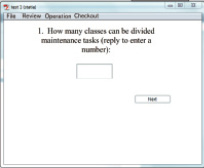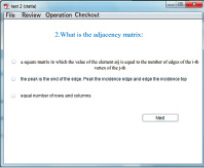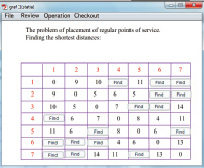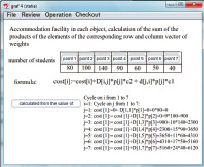Keywords: logistics, Adobe Flash, courseware
Development of the courseware is carried out on the example of the topic «Placement of Regular Service Centre» in the course «Logistics». The courseware consists of three modules:
1) «theoretical material»;
2) «test»;
3) «training simulator».
In the «theoretical material» module lecture on the subject «placement of regular service centers» is represented for the students. This module consists of four blocks:
1. Introduction.
2. Necessary specifications.
3. Algorithm.
3.1. Textual algorithm description.
3.2. Formal algorithm description in the form of the flowchart.
4. Example solution.
All blocks provide the use of hyperlinks. That is made in order to help the student who doesn’t know any definition or phrase, don’t spend his time and just click on definition to follow the link to receive additional information.
In the «test» module the student is given the opportunity to check the learned material. The student has to answer questions on this topic. In this module questions of bothtypes, closed and opened, were used. Open questions assume a definite answer which the student has to enter by itself (Fig. 1). Closed questions are questions in which some variants of answers are provided to the student and he has to choose one or more, that are correct (Fig. 2).
Open questions allow the student to enter the answer in numeral or wordform. The closed question means oneor more correct answersfrom several variants.
In the «training simulator» module the student needs to analyse a matrix and to process data by Floyd-Uorshella algorithm for the purpose to find minimum value for optimum placement of regular service centers. The «training simulator» module will work in two modes: «Demo» and «Control». The «Demo» mode will allow the student to look on a concrete example as standard problems are solved. The «Control» mode will allow to reveal extent of understanding of the studied material in points.

Fig. 1. Openquestion

Fig. 2. The closed question with one variant of the answer
At an entrance to the «training simulator», the student is given the opportunity to choose dimension of a matrix. After that the student gets on a slide, where the matrix with values depending on the chosen dimension is represented, with the «find» buttons (Fig. 3).

Fig. 3. Matrix of the Shortest Distances
By pressing the «find» button, the «training simulator» will show to the student how to find the shortest way from each top to another and to find among them the minimum value by searching all over possible ways by Floyd-Uorshalla algorithm. The minimum value will be marked out with green color (Fig. 4).

Fig. 4. Search of all available values of top. Finding of the minimum value
After that the student has to press the button «return to an initial matrix» and in the initial matrix value will be illuminated by green color.
The student has to find all values in the matrix and after that it becomes possible to receive a total matrix of the shortest distances. After finding of a total matrix of the shortest distances, the student is given the opportunity to look how the calculation of the sum of multiplications of elements of the corresponding line and column on a weight vector to find optimum point of placement of a regular service center (Fig. 5).

Fig. 5. Calculation of the sum of multiplications of elements of a line and column on a weight vector
The number of pupils is generated in a random manner, the student has to press by terns the buttons «point 1», «point 2», etc. Then the student has to press the button «calculate value on a formula» and nearby the result on point 1 will be output, then, in this case, he has to look at results at all 7 points.
After that the student gets on a slide in which when pressing the button «value in point 1» all answers of the previous slide (to Fig. 6) will be output.

Fig. 6. Finding of point and number of ucheniko-kilometers where it is necessary to arrange school
By pressing the «point in which it is necessary to arrange school» button, he in this case, will receive top 2, when pressing the «number of ucheniko-kilometers on the way to school» button value 3440 will be removed.
In the «control» mode the student should enter all values manually, there will be no prompts, at incorrect value introduction two times, The student won’t be able to pass to the following stage of the solution of a task, if he has entered incorrect answer two times, in this case he should choose other task and to start solving it again.
The advantage of this practical work is casual generation of matrixes by the computer (on the set set of parameters) that allows to provide always to students various tasks in a look convenient for visual perception [3].
Development of the courseware is carried out in the programming environment Adobe Flash, allowing quickly and effectively to create highly – interactive appendices. The courseware has to help the teacher with examination of students and increase interest of students in the course of material studying. This laboratory courseware will allow to bring teaching process to new level and to increase quality of training in the field of applied mathematics, information technologies and logistics [4].
Библиографическая ссылка
Bushina K.S., Tikhomirova A.N., Sidorenko E.V. THE USE OF MODERN INFORMATION TECHNOLOGIES FOR DEVELOPENT OF THE COURSEWARE ON THE EXAMPLE OF THE TASK FROM THE COURSE «LOGISTICS» // Международный журнал экспериментального образования. 2014. № 2. С. 5-7;URL: https://expeducation.ru/ru/article/view?id=4602 (дата обращения: 02.01.2026).

